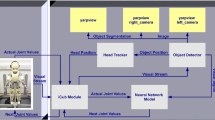Abstract
Language is symbolic system, from which human intelligence originates. A robot is expected to use language. Recently a large amount of text corpus can be obtained, and human knowledge lies there. Thus, it is important for the robot to acquire the knowledge and to develop the ability to use language. This paper describes a novel approach to a humanoid robot that makes linguistic inference by using language knowledge in the dictionary. Sentences are interpreted as broader concepts according to the dictionary. The association between the broader concepts is stochastically represented. The abstract referential relationship between sentences and broader concepts, and the associative relationship among the broader concepts allow the robot to make linguistic inference by generating sentences from input one. As one of applications of the proposed linguistic inference, this framework is integrated with the symbols of motion patterns. The developed application demonstrates the validity of the proposed framework since the robot can make linguistic inference and associate motion patterns subsequently.
Access this chapter
Tax calculation will be finalised at checkout
Purchases are for personal use only
Preview
Unable to display preview. Download preview PDF.
Similar content being viewed by others
References
Deacon, T.: Symbolic species: The co-evolution of language and the brain. W.W.Norton and Company Inc. (1997)
Rizzolatti, G., Fogassi, L., Gallese, V.: Neurophysiological mechanisms underlying the understanding and imitation of action. Nature Reviews, 661–670 (2001)
Donald, M.: Origin of the modern mind. Harvard University Press, Cambridge (1991)
Tani, J., Ito, M.: Self-organization of behavioral primitives as multiple attractor dynamics: A robot experiment. IEEE Transactions on Systems, Man and Cybernetics Part A: Systems and Humans 33(4), 481–488 (2003)
Sugita, Y., Tani, J.: Learning semantic combinatoriality from the interaction between linguistic and behavioral processes. Adaptive Behavior, 33–52 (2005)
Ogata, T., Murase, M., Tani, J., Komatani, K., Okuno, H.G.: Two-way translation of compound sentences and arm motions by recurrent neural networks. In: Proceedings of the IEEE/RSJ International Conference on Intelligent Robots and Systems, pp. 1858–1863 (2007)
Kadone, H., Nakamura, Y.: Symbolic memory for humanoid robots using hierarchical bifurcations of attractors in nonmonotonic neural networks. In: Proceedings of the 2005 IEEE/RSJ International Conference on Intelligent Robots and Systems, pp. 2900–2905 (2005)
Haruno, M., Wolpert, D., Kawato, M.: Mosaic model for sensorimotor learning and control. Neural Computation 13, 2201–2220 (2001)
Inamura, T., Toshima, I., Tanie, H., Nakamura, Y.: Embodied symbol emergence based on mimesis theory. International Journal of Robotics Research 23(4), 363–377 (2004)
Billard, A., Calinon, S., Guenter, F.: Discriminative and adaptive imitation in uni-manual and bi-manual tasks. Robotics and Autonomous Systems 54, 370–384 (2006)
Takano, W., Yamane, K., Sugihara, T., Yamamoto, K., Nakamura, Y.: Primitive communication based on motion recognition and generation with hierarchical mimesis model. In: Proceedings of the IEEE International Conference on Robotics and Automation, pp. 3602–3609 (2006)
Sugiura, K., Iwahashi, N., Kashioka, H., Nakamura, S.: Active learning of confidence measure function in robot language acquisition framework. In: Proceedings of the IEEE/RSJ International Conference on Intelligent Robots and Systems, pp. 1774–1779 (2010)
Takano, W., Yamane, K., Nakamura, Y.: Capture database through symbolization, recognition and generation of motion patterns. In: Proceedings of the IEEE International Conference on Robotics and Automation, pp. 3092–3097 (2007)
Takano, W., Nakamura, Y.: Statistically integrated semiotics that enables mutual inference between linguistic and behavioral symbols for humanoid robots. In: Proceedings of the IEEE International Conference on Robotics and Automation, pp. 646–652 (2009)
Takano, W., Nakamura, Y.: Incremental learning of integrated semiotics based on linguistic and behavioral symbols. In: Proceedings of the IEEE/RSJ International Conference on Intelligent Robots and Systems, pp. 2545–2550 (2009)
Takeuchi, K., Matsumoto, Y.: Hmm parameter learning for japanese morphological analyzer. In: Proceedings of the 10th Pacific Asia Conference on Language, Information and Computation, pp. 163–172 (1995)
Takano, W., Nakamura, Y.: Humanoid robot’s autonomous acquisition of proto-symbols through motion segmentation. In: Proceedings of the IEEE-RAS International Conference on Humanoid Robots, pp. 425–431 (2006)
Kudo, T., Yamamoto, K., Matsumoto, Y.: Applying conditional random fields to japanese morphological analysis. In: Proceedings of the 2004 Conference on Empirical Methods in Natural Language Processing, pp. 230–237 (2004)
Author information
Authors and Affiliations
Corresponding author
Editor information
Editors and Affiliations
Rights and permissions
Copyright information
© 2014 Springer-Verlag GmbH Berlin Heidelberg
About this chapter
Cite this chapter
Takano, W., Kanazawa, M., Nakamura, Y. (2014). Motion-Language Association Model for Human-Robot Communication. In: Khatib, O., Kumar, V., Sukhatme, G. (eds) Experimental Robotics. Springer Tracts in Advanced Robotics, vol 79. Springer, Berlin, Heidelberg. https://doi.org/10.1007/978-3-642-28572-1_2
Download citation
DOI: https://doi.org/10.1007/978-3-642-28572-1_2
Publisher Name: Springer, Berlin, Heidelberg
Print ISBN: 978-3-642-28571-4
Online ISBN: 978-3-642-28572-1
eBook Packages: EngineeringEngineering (R0)




